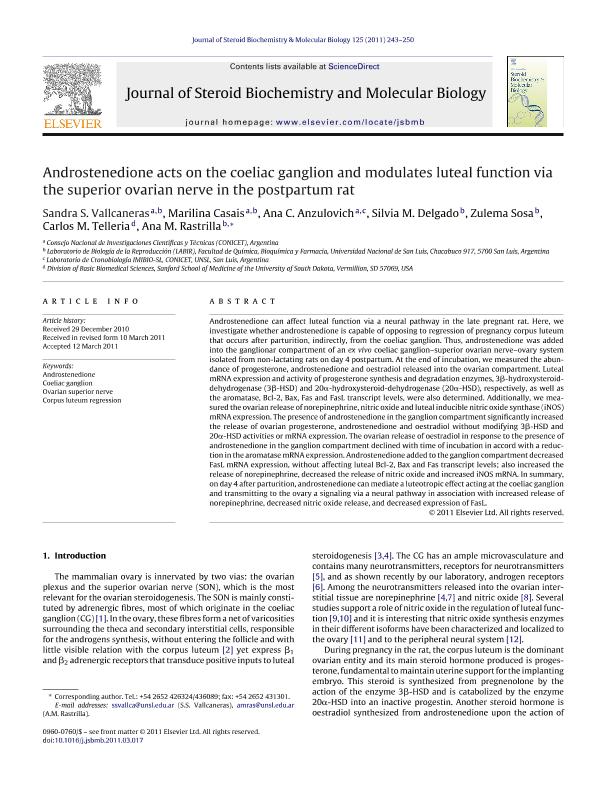Artículo
Androstenedione acts on the coeliac ganglion and modulates luteal function via the superior ovarian nerve in the postpartum rat
Vallcaneras, Sandra ; Casais, Marilina
; Casais, Marilina ; Anzulovich Miranda, Ana Cecilia
; Anzulovich Miranda, Ana Cecilia ; Delgado, Silvia M.; Sosa, Zulema; Telleria, Carlos Marcelo
; Delgado, Silvia M.; Sosa, Zulema; Telleria, Carlos Marcelo ; Rastrilla, Ana M.
; Rastrilla, Ana M.
 ; Casais, Marilina
; Casais, Marilina ; Anzulovich Miranda, Ana Cecilia
; Anzulovich Miranda, Ana Cecilia ; Delgado, Silvia M.; Sosa, Zulema; Telleria, Carlos Marcelo
; Delgado, Silvia M.; Sosa, Zulema; Telleria, Carlos Marcelo ; Rastrilla, Ana M.
; Rastrilla, Ana M.
Fecha de publicación:
07/2011
Editorial:
Elsevier
Revista:
Journal of Steroid Biochemistry and Molecular Biology
ISSN:
0960-0760
Idioma:
Inglés
Tipo de recurso:
Artículo publicado
Clasificación temática:
Resumen
Androstenedione can affect luteal function via a neural pathway in the late pregnant rat. Here, we investigate whether androstenedione is capable of opposing to regression of pregnancy corpus luteum that occurs after parturition, indirectly, from the coeliac ganglion. Thus, androstenedione was added into the ganglionar compartment of an ex vivo coeliac ganglion–superior ovarian nerve–ovary system isolated from non-lactating rats on day 4 postpartum. At the end of incubation, we measured the abundance of progesterone, androstenedione and oestradiol released into the ovarian compartment. Luteal mRNA expression and activity of progesterone synthesis and degradation enzymes, 3β-hydroxysteroid-dehydrogenase (3β-HSD) and 20α-hydroxysteroid-dehydrogenase (20α-HSD), respectively, as well as the aromatase, Bcl-2, Bax, Fas and FasL transcript levels, were also determined. Additionally, we measured the ovarian release of norepinephrine, nitric oxide and luteal inducible nitric oxide synthase (iNOS) mRNA expression. The presence of androstenedione in the ganglion compartment significantly increased the release of ovarian progesterone, androstenedione and oestradiol without modifying 3β-HSD and 20α-HSD activities or mRNA expression. The ovarian release of oestradiol in response to the presence of androstenedione in the ganglion compartment declined with time of incubation in accord with a reduction in the aromatase mRNA expression. Androstenedione added to the ganglion compartment decreased FasL mRNA expression, without affecting luteal Bcl-2, Bax and Fas transcript levels; also increased the release of norepinephrine, decreased the release of nitric oxide and increased iNOS mRNA. In summary, on day 4 after parturition, androstenedione can mediate a luteotropic effect acting at the coeliac ganglion and transmitting to the ovary a signaling via a neural pathway in association with increased release of norepinephrine, decreased nitric oxide release, and decreased expression of FasL.
Archivos asociados
Licencia
Identificadores
Colecciones
Articulos(IMIBIO-SL)
Articulos de INST. MULTIDICIPLINARIO DE INV. BIO. DE SAN LUIS
Articulos de INST. MULTIDICIPLINARIO DE INV. BIO. DE SAN LUIS
Citación
Vallcaneras, Sandra; Casais, Marilina; Anzulovich Miranda, Ana Cecilia; Delgado, Silvia M.; Sosa, Zulema; et al.; Androstenedione acts on the coeliac ganglion and modulates luteal function via the superior ovarian nerve in the postpartum rat; Elsevier; Journal of Steroid Biochemistry and Molecular Biology; 125; 3-5; 7-2011; 243-250
Compartir
Altmétricas



